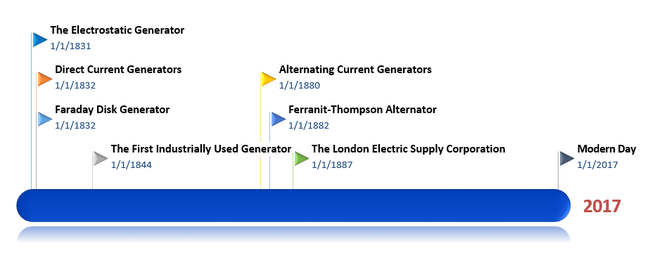A History of Power (Generation)

The Electrostatic Generator
Early versions of the generator were electrically charged belts, plates, and disks that carried charge to a high potential electrode. These had high voltage and low current, and really only had 2 practical applications - to power x-ray tubes and atomic particle accelerators (everything has to start somewhere!).
Faraday Disk Generator
Michael Faraday first created 'Faraday's Law' in 1832:
"Electromotive force is generated in an electrical conductor which surrounds a varying magnetic flow".
From this theory, he created his first electromagnetic generator 'Farady's Disc' (Inventors surprisingly don't seem to have much creativity). This electromagnetic generator used a copper disc, rotating between the poles of a horseshoe magnet and it produced a small DC voltage.
Direct Current (DC) Generators
A coil of wire rotating in a magnetic field produces a current which changes direction with each 180 degree rotation, creating an alternating current (AC). Many early uses of electricity required DC, which was a bit of an issue when the generators were creating AC current.In the first practical electric generators (Named Dynamos), AC was converted into DC using a commutator (which essentially reversed the connection of the current every 180 degree rotation of a shaft, creating a pulsing DC current). Dynamo's, built in 1832 by Hippolyte Pixii, were the popular choice of generator for a while because they started using electromagnets making the generator far more powerful.
Alternating Current Generators
The Dynamo was succeeded by many later inventions - particularly the AC alternator. The first alternator was actually built by Faraday, using a rotating rectangle that pushed conductors through different areas of the magnetic field, going in different directions.
Industrial Generator
The first electrical generator was created and used in 1844, by the Woolrich Electrical company.
Ferranti-Thompson Alternator
The first Ferranti-Thompson Alternator produced between 100-300hz. Ferranti then went on to design the Deptford Power Station for the London Electric Supply Corporation in 1887, and it used an AC system.
Modern Day
The most common type of power generator is the generator we know today - portable camping sized ones up to industrial power plants which are used for backup power or to power off-grid sites. Generators have a wide range of applications these days, including caravan power, power tool power supply, backup power, off-grid living, and much more!
Macfarlane Generators stocks all types of generators, and we have our own extensive company history too. Give us a call today and ask about how a generator can benefit you!

